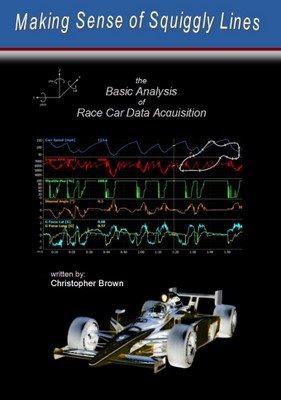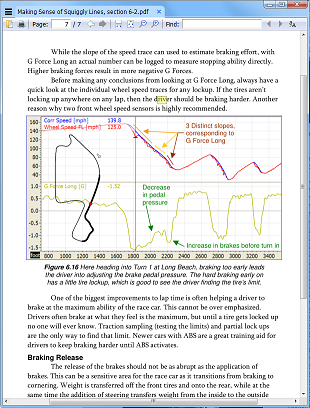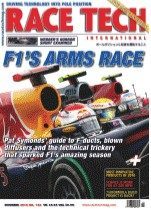Data points are just words, but when connected with a squiggly line they tell a story….

“Making Sense of Squiggly Lines” lays the foundation of knowledge required to analyze the data recorded on a race car. Its simple approach is perfect for beginners, while the author’s meticulous attention to the details and pitfals of data will improve even the experienced engineer.
This book is comprised of 144 pages with 166 figures and 15 tables.
Download a sample of this book
Section 6-2 on Braking (PDF file, 205 KB)
As Featured....
in Race Tech magazine!
See their December 2012 issue, or click above to read it on the speedreaders.info web site.
“Making Sense of Squiggly Lines”
Table of Contents
Chapter 1 Introduction
Chapter 2 Speed
Chapter 3 RPM
Chapter 4 Gear
Chapter 5 Throttle
5.5 – Throttle Application – Ideal Line
Chapter 6 G-Force
Chapter 7 Steering
Chapter 8 Track Mapping
Chapter 9 Section Timing
Chapter 10 Video
Chapter 11 Putting it All Together
Appendix A – Recommended Logging Rates
Appendix B – Glossary of Terms
Index
Get your copy today !
What others are saying….
A very approachable tome that focuses on driver engineering through the intelligent use of data. Chris’ explanations are wonderful and the premise of the book (as indicated by the title) is well executed. Probably the best single book for learning what to look at FIRST for the Club and Track Day driver. Highly recommended!
I’ve started through it, and I must say that this is the Buddy Fey replacement that we’ve been waiting for!
So far I’m about 60 pages into the book and loving it. The book is going to cost a lot more than I thought because it looks like I’m upgrading my data logging capabilities!
I have been involved with the San Francisco Region Driver School since the early 70’s and for the past couple of years have been leading a group for advanced and experienced drivers. In the school last year I recommend the students get your book and read it regardless of whether they had a Data Acquisition system or not, it is a great book on competition driving, and should be read as much for the driver coaching as for the data acquisition. Thank you for a fabulous book!

